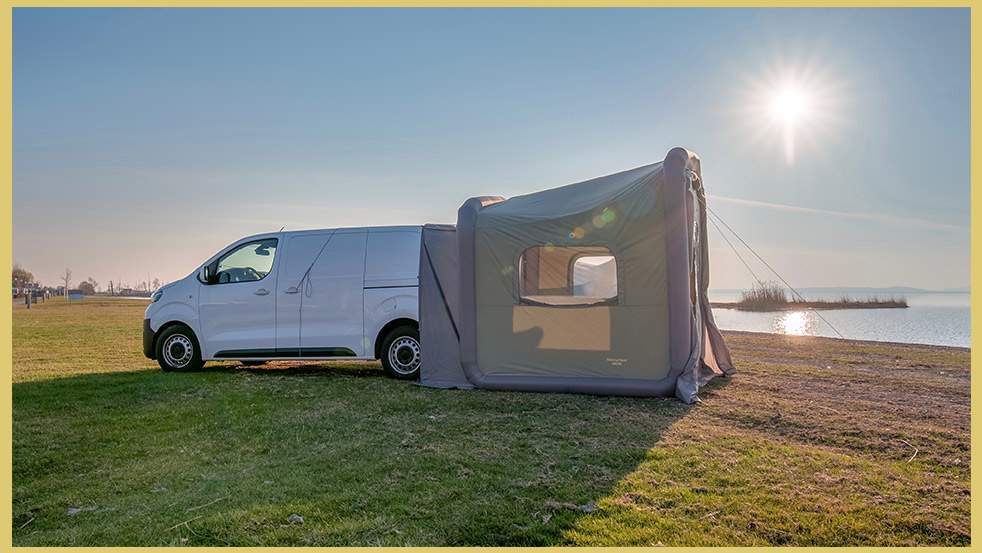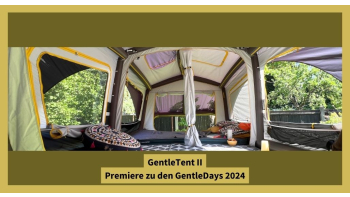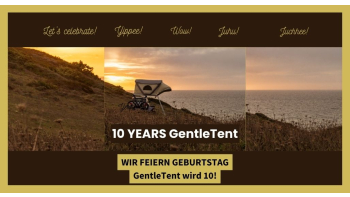
If you want to go on a camping adventure and take the comfort of an awning with you on your journey, you have certainly already set out on the not quite easy search for a suitable awning. Size, type, materials, costs - what do you look at first? Freestanding or not? Inflatable or with poles? Here are some information and guidelines to help you when purchasing an awning.
Price of an awning
It is often unclear what price to expect when buying an awning. The prices range from € 100 for the simplest to € 2,000 - € 3,000 for awnings with various functions, high-quality materials and accessories. With such a wide price range it is therefore important to ask yourself which functions and concrete needs that the awning should fulfil.
Intended use of the awning
The best thing to do is to answer the following questions before buying an awning:- With which vehicle does one travel most often with? Whether you are travelling by van, caravan, bus or car - the type of vehicle determines the approximate size and type of attachment of the awning. Only a few awnings are as multifunctional as the GT BOX and can be connected to different types of vehicles.
- Location-bound or constantly on tour? Different awnings are difficult to pitch. If you set off every day early in the morning, you will save time, work and nerves with an inflatable awning with simple assembly and dismantling. If you stay at the same place throughout the 4 seasons, you can think about a fixed pavilion.
- How much space is available for its transportation? How heavy can it be? The packing size, the weight and the handling can also be a decision aid when buying an awning. What is the maximum size of the pack to have enough space for other things in the vehicle? How much weight is it allowed to have in order not to exceed loading capacities? The lighter an awning, the easier it is to load and unload.
- Should the awning serve as an extended living room, small kitchen awning, universal space or storage space? - The desired area of use must also be taken into account in the size of the awning.
Awning variants
The selection of the right variant for your awning purchase goes hand in hand with the question of the intended use. Here we present a few basic explanations:
- Freestanding awning vs. non-freestanding awning: Freestanding awnings are awnings that stand alone without fastening and are therefore "vehicle-independent". They offer the greatest flexibility, as they allow the vehicle to be driven away and can easily remain at the campsite during day trips without being set up or dismantled. They are then simply connected to the vehicle again using a zip system. Awnings that are not free-standing cannot be erected without brackets. They must be permanently connected to the vehicle. Because they are made of less material (they do not need a rear wall, for example) and because they are less comfortable, they are usually cheaper. Instead of a freestanding awning vs. a non-freestanding awning, the term partial tent or complete tent is often used in this context.
- Inflatable awning vs. awning with poles: Inflatable awnings are the future of the camping industry: they are mostly freestanding, are light in weight, have a small packing size and are characterized by their easy handling. They consist of a two-layer air hose system, similar to that of a bicycle hose, and are inflated with an electric pump. With the possibility of attaching them to the ground with tension ropes, they offer just as much support as awnings with poles. The simple set-up saves time because the poles are missing, space and weight in the vehicle. Awnings with poles continue to enjoy great popularity - despite their disadvantages in terms of weight, construction and transport - because they are considered robust and have good support. Poles are available in various designs, most often made of aluminium. However, there are also cheaper fibreglass poles, extra robust carbon poles or galvanised steel poles.
Material & Coating of Awnings
Which material an awning is made of and which coating it has, has a big effect on the price, because high-quality fabrics cost money. These awning materials of different quality that are often used depending on weather conditions and function:Material
- Cotton: As a robust and breathable material, cotton is used by Ten Cate, among others, and is resistant to rot and mildew.
- PolyCotton: A blended fabric of polyester and cotton is also often used, with polyester providing greater strength. As the name suggests, PolyCotton combines the properties of polyester and cotton.
- 100% Polyester: Polyster is a synthetically produced fibre that is versatile and less demanding than cotton. Fabrics made of 100% polyester are light and robust, but hardly breathable.
Coating
- PVC-coated fabric: Double-coated tent fabric is relatively heavy, but the PVC makes it extra robust and windproof.
- Acrylate coating: Acrylate coating serves as an additional water repellent and is extra easy-care.
Fixing of the awnings
If you want to buy an awning, you should find out in advance what mounting options your own vehicle offers.- Piping rail: Piping rails can be found on many caravans. The tent canvas is simply piped in and, if necessary, additionally tensioned. If a piping rail is not yet available, it can also be installed on the vehicle itself.
- Marquee: Alternatively, an awning can also be laid over an awning and tensioned by simple handling. Some awnings are also supplied with suction cups (folding suction cups with clamps) or Velcro fasteners.
Sizing
The size of the awning is different depending on the type.- Partial tent (not free-standing awning): Partial tents are attached to only one part of the vehicle, usually the roof. To determine the size, pull a non-stretchable thread through the keder strip on the roof and measure the length.
- Whole tent (freestanding awning): Here you have to determine the circumferential length. Here, too, an non-stretchable thread or similar is used: It starts on the ground at the rear end of the car, then the thread is guided through the entire keder strip up to the ground at the front tensioning point of the vehicle. The vehicle should stand on horizontal ground.
- Alternatively, many websites also offer size calculators, i.e. databases that indicate the orbital size after entering the model of the vehicle.
Purchasing an awning: The best tips at a glance
- We have selected the best tips for when you proceed with purchasing an awning
- 1. Determine the vehicle and size of the awning
- 2. Take into consideration location & weather, these affect material and gear
- 3. Type of journey: Long-term stay or rather mobility and speed in set-up?
- 4. Don't forget: The inner dimensions of the awning, the weight and where the entrance is to be located also play a role when purchasing an awning.



